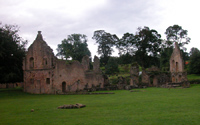 |
 |
 |
 |
 |
 |
 |
|
Cistercian hospitality (1/6) Let all guests be received as Christ
Himself for He will say, Upon arriving at the abbey gate, visitors were greeted courteously by the porter, who was responsible for welcoming guests and presenting a positive first impression of the community. However, he was also to control access and ensure that the monks were not unduly disturbed by the arrival of outsiders. Thus, if a visitor arrived when the community was celebrating the Divine Office in the church, it was the porter’s duty to explain that it was not their custom to speak at such times and his arrival could not be announced to the abbot until the brethren had finished singing the Office.(1) The porter therefore balanced deference with firmness, and was the link between the community and outsiders.
Once the porter or his deputy had announced the guest’s arrival to the abbot, two monks were sent to pray with the newcomer and to bestow the kiss of peace; thereafter the guest was edified with the Divine Word. The visitor was then ready to enter the guest complex where he was introduced to the hosteller or guestmaster, as he was also known, who provided for guests according to their standing and relationship with the community.(2) The guestmaster was invariably helped by at least one lay-brother. Soon after his arrival, the visitor’s feet were washed; this was known as the Maundy of guests. The guest complex might, as at Fountains Abbey in Yorkshire, include a guest hall and houses.(3) Whereas noble visitors and their households would have been shown to private chambers, those of lesser means (for example, travellers on foot) would have been directed to a public hall which, by all accounts, could be rather rough and unruly. In the mid-thirteenth century a fight broke out in the guesthall at Furness and guests were stabbed to death by visiting grooms.(4) An ‘untoward event’ occurred in the guesthall refectory of Margam Abbey in 1180, when a young man was found dead on the very spot where he had struck another visitor the previous day.(5) It is hardly surprising that the archdeacon and satirist, Gerald of Wales, complained bitterly when, on the abbot of Whitland’s orders, it was instructed that he should not be received as the archdeacon or elect but shown to the public hall, ‘with the common folk and the noise of the people.’ (6) Visiting Cistercians would not have stayed in the guest complex but were shown to the claustral area, where they would have slept in the monks’ dormitory or an adjacent chamber, and dined in the monks’ refectory. Cistercian prelates mat have stayed with the abbot or in the infirmary. |
||||
